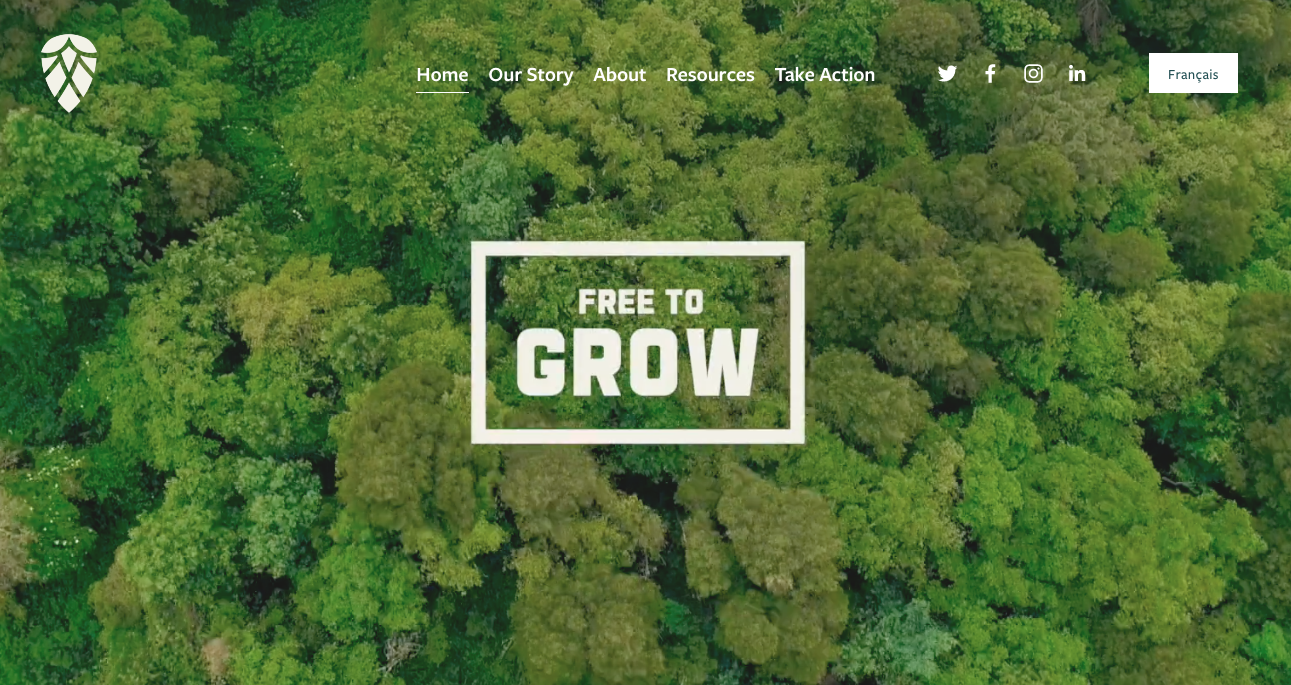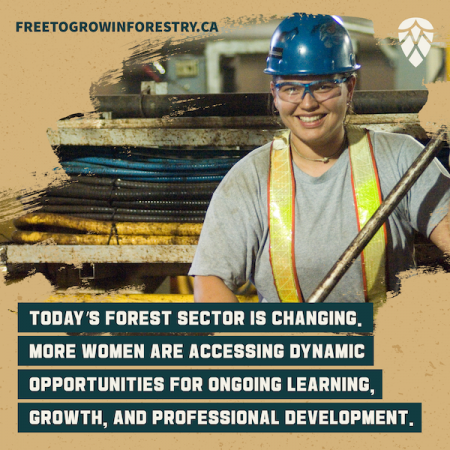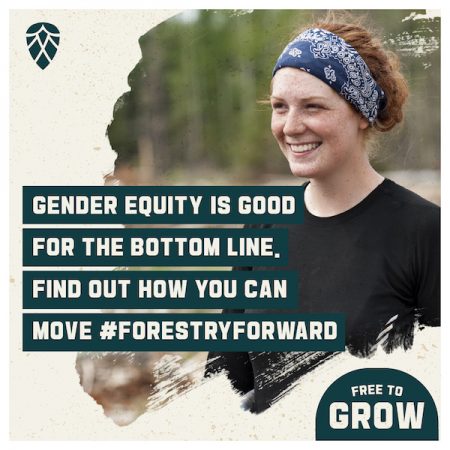
Growing the industry: Forestry’s gender equity plan delivers new online hub
January 20, 2021
By Kristina Urquhart

Free to Grow in Forestry, a new online information portal on diversity and inclusion (D&I) in forestry, will be the legacy of a three-year, cross-country strategy on gender equity that concludes this June.
While this marks the final year of the government-mandated Canada’s Gender Equity in Forestry National Action Plan, it’s just the beginning for D&I practices in the industry, says Kelly Cooper, co-leader of the project’s steering committee.
Since 2018, Cooper’s D&I consulting firm, the Centre for Social Intelligence (CSI), has been working alongside The Canadian Institute of Forestry-Institut du forestier (CIF-IFC) on the action plan, which aims to create awareness of gender parity. The organizations are guided by twice-yearly meetings of a committee of industry representatives from Indigenous communities and the public, private, academic and non-profit spheres.
At the outset, CSI and CIF-IFC developed a nationwide vision for the sector: that a diverse and inclusive workforce leads to economic competitiveness and stronger communities where forestry companies operate.

The Free to Grow in Forestry website includes shareable images as part of the #ForestryForward campaign. Photo: FreeToGrowInForestry.ca
They also created a framework for action: to gather current D&I data in one place for the first time, and identify data gaps to be filled; to develop tools that can be applied by forest sector companies to foster an inclusive workforce; and to attract more women to the sector.
“The forest sector has been a traditionally male-dominated sector,” says Luc Rainville, the CIF-IFC representative on the steering committee. The data supports this – forestry’s total workforce is comprised of just 17 per cent women, and seven per cent Indigenous people.
“We knew this was the case, but what we are doing now is establishing a clear baseline on where the sector stands on workforce composition, so we are able to see where we started,” Rainville says. “This helps us measure our success going forward.”
We last checked in on the project in October 2019. Here’s a look at what’s been done so far, and what’s still on the agenda for 2021.
Data shows employment, wage gaps
The team’s first priority was to corral available D&I data in one place, and then establish where they needed more robust information.
Representatives from Statistics Canada and the Forest Products Association of Canada (FPAC) helped to contextualize existing census data on the proportions of women and men in various occupations within the sector, and on salary and benefits gaps.
“The data reveals that there is a wage gap between the two genders, and that helps us to zero in on what equity measures should be taken to address that,” explains Rainville.
The research showed the pulp and paper sub-sector is comprised of 20 per cent women, while the wood products and forestry/logging sub-sectors are lower, at 16 and 13 per cent respectively. Women make up 21 per cent of forestry support (administrative) jobs. In addition, women in the forestry sector earn, on average, less than men for the same job – and, in eight of the top 20 forest industry occupations, that salary spread is greater than 25 per cent.
“The data reveals that there is a wage gap between the two genders, and that helps us to zero in on what equity measures should be taken to address that,” explains Rainville.
To get more context on why these gaps exist and persist, CIF-IFC and CSI are working on a series of qualitative interviews with women who are currently employed in the sector, and with women who have left it, to determine whether or not women and men have equal opportunities for advancement, how child-rearing affects the employment of each gender, and how Indigenous women have uniquely experienced the industry.
These interviews “will eventually start shaping the story of what’s going on in the sector,” Cooper says.
“It’s important to understand that injecting a pay equity measure into an organization is not going to solve the gender inequalities. There are many actions that can be undertaken to improve the culture of the organization that, when guided by engaged leadership, will make a difference.”
Changes needed for all genders
The organizations say the need for an overall strategy was born out of a lack of advancement opportunities for women in the forestry sector, low retention rates, wage gaps and culture problems within work environments.
The actions taken so far are not only beneficial for women in the workplace from a societal standpoint – they’re good for business as well, Cooper says. Ultimately, there are economic benefits to women working in the sector.
She cites research from Deloitte, which shows that diverse and inclusive teams are twice as likely to meet or exceed their targets, six times more likely to be innovative and agile and eight times more likely to achieve better business outcomes.
The organizations found that highlighting Indigenous women’s leadership in the forest sector and their connection to the land is also key to changing perceptions – and crucial to recruiting young Indigenous women to join the industry.
In order to foster an inclusive culture, Cooper says women need to feel like they are welcome in the sector, and men need to understand their roles in encouraging, retaining and advancing women in their careers.
The organizations found that highlighting Indigenous women’s leadership in the forest sector and their connection to the land is also key to changing perceptions – and crucial to recruiting young Indigenous women to join the industry.
“Our workforce is changing quickly, and with labour market demand increasing due to baby boomers retiring, the sector needs to pivot to be more welcoming to women and to men of diverse and inclusive backgrounds,” says Cooper.
She stresses that a more inclusive workplace environment is not only a boon for women – throughout the research process, she’s found that men in the forest products industry experience harassment on job sites, too.
In response, CSI has created a “plan to eliminate resistance” for companies, which delves into why change management can be challenging and what strategies are required to combat resistance across leadership, communications and human resources.
What’s still to come
The final point in the action plan is to reposition the forest sector and enable it to change, which has been ongoing over the past three years, says Cooper.
Instrumental to that is the project’s steering committee – these people are now “champions” within the sector who can continue to spread inclusive thinking within their own organizations and regions.
They’ll also help to push out that aforementioned D&I website called Free to Grow in Forestry. The name is a play on “free to grow” – which is what the industry calls a forest in natural recovery, meaning there are no more interventions required.
The bilingual website, which will be managed long term by CIF-IFC, contains gender equality principles, surveys that will help to build out qualitative data, and shareables for organizations to show that their workforce is “free to grow” using the social media hashtag #ForestryForward.
It will also be the future home of additional tools that companies can incorporate into their organizations, including an inclusive leadership report, due this spring, which Cooper says will be a collection of best practices from companies in other industries that have been certified in gender equality in the workplace.
“What differentiates what I call traditional leadership from inclusive leadership is with inclusive leadership, you’re looking at how you’re connected to the community around you. And that’s what this report will start to share,” she says. “It’s a different way of thinking about sustainable development.”
Also coming to the site is an “allies’ toolkit” that will help to guide men in the sector as they build more inclusive workplaces and advance females to senior leadership and technical positions.
“With inclusive leadership, you’re looking at how you’re connected to the community around you,” says Cooper.
Talk is now underway to create a second phase of the project. In it, Cooper envisions a regional approach. “A regional focus will allow us to get into the supply chain aspects of the sector, ensuring all groups are engaged and taking action,” she says.
“Phase one was ‘vision to action. I talk about phase two in the terms of ‘action to traction.’ That means getting on the ground, getting in the regions and doing training.”
This article originally appeared in the Winter 2021 issue of Pulp & Paper Canada.
Print this page
